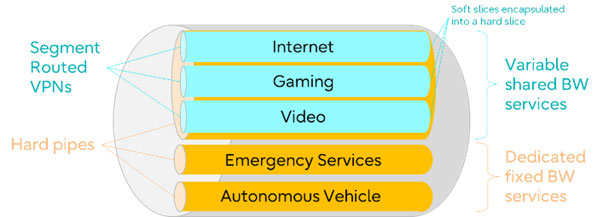
Network slicing can optimize brownfield and greenfield networks
In the last installment of this blog series, we looked at virtualizing the network as a single programmable infrastructure for the many 5G disparate service offerings compared to an overbuild approach. We also reviewed how the white-box approach offers the best performance scaling technique compared with purpose-built equipment for RAN and transport elements by disaggregating the hardware from the software. This blog installment dives deeper into network slicing by comparing techniques in the optical transport layers for efficient and guaranteed slicing in brownfield and greenfield networks.
ITU-R 5G service models
Previously, I described how Service Operators relate the ITU-R 5G service models to various use cases. Wholesale services offers direct enhanced Mobile Broadband (eMBB) to other carriers. Healthcare and Finance applications use Ultra Reliable Low Latency Connectivity (URLLC). The third category in the model uses massive Machine Type Communications (mMTC) for Enterprise and Smart City services.

Fig 1: ITU-R 5G service models
Network slicing provides an economic alternative to network overlay approaches for service providers by offering two or more of these services within a single network infrastructure. Each of these service models have a unique set of capabilities differing in isolation and flexibility. Slice isolation is used to maintain performance and security independence from the other services. These services vary from strict for ultra-low latency and mission critical services and to a lesser extent for entertainment, such as gaming and streaming video services. Where strict policies are used less flexibility exists, which impacts scaling and efficiencies.
Hard and soft slicing approaches overcome the adverse impacts of deploying these disparate services within slicing. Hard slicing offers a dedicated approach to services providing guaranteed isolation and predictable performance between slices. Hard slicing is ideal for low-latency and mission critical services. Soft slicing offers flexibility for dynamic and on-demand shared services, such as VPNs. The results of soft slicing provide resource efficiency for statistically multiplexing capacity among shared resources and scalability to adapt to changing service demands.
Hybrid network slicing
The figure below shows where hard and soft slicing are combined for a hybrid slicing use case. Three dynamic services (including Internet access, gaming, and video streaming) are each soft sliced and encapsulated with a hard slice to leverage bandwidth capacity on-demand for service performance and efficiency. Mission critical services for emergency communications and autonomous vehicle operation are given their own dedicated hard slices, which offers guarantees for isolation, predictability, and performance between all three hard slices.

Fig 2: Hybrid slicing use case
Implementing network slicing into today’s optical transport networks provides an economic benefit and performance balance. Hard slicing can be implemented several ways, but I will address the most popular methodologies. Most packet networks are utilizing MPLS. Adding Segment Routing-Traffic Engineering (SR-TE) is typically a software upgrade to an existing packet network if given capacities are adequate for the planned services. This will involve a custom controller with robust control plane for automation and near real-time operation. An alternate approach designed to optimize and provide low latency services is implementing Flex-E for hard slicing in the packet network. Flex-E has inherent automation to allocate and adjust bandwidth in near real-time. The caveats with Flex-E include a more costly approach as it will likely require a potential hardware upgrade and as of this post, has limited vendor interoperability, locking the service provider into a single vendor for the entire Flex-E transport network.
Soft slicing has a similar implementation approach as the hard slicing methods described above. SR-TE can be easily added to an existing packet network with a software upgrade. SR-TE offers simplified traffic engineering defining an explicit path and steering traffic flows. It is optimized for efficient scaling and interoperates across different vendor implementations. SR-TE Flex-Algo offers more flexibility allowing operators to create customized TE algorithms, have more granular control, and seamlessly integrate with segment routing. The downside is that different vendors may have variations yielding interoperability challenges in multivendor environments.
Smooth evolution for transport
A smooth evolution strategy to minimize first cost and expedite brownfield network implementation is to use a white-box transport approach. The white-box transport approach disaggregates the software from the hardware allowing the service provider to cost effectively implement hard and soft slicing in the edge network for access and aggregation using MPLS with SR-TE and VLANs while maintaining interoperability with other vendor implementations through mature protocols and avoiding single vendor lock-in. Later as Flex-E and Flex-Algo are more widely adopted, the software can be upgraded to implement these high-performance implementations of hard and soft slicing. Further, if any transport sites have capacity challenges, the disaggregated hardware can be easily upgraded with open hardware to accommodate the capacity demands and avoid the development phase associated with purpose-built hardware and closed systems.
The next blog installment will put all this information together by discussing how to manage the slices between RAN, transport, and core with Service Management Orchestration (SMO).